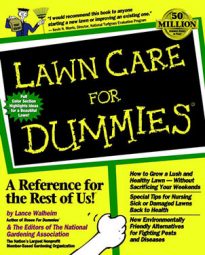If you’re not sure what type of grass to plant, you need to determine what you value most in a lawn. The most commonly planted cool-season grasses include bent grass, Kentucky bluegrass, fescues, and ryegrass:
Bent grasses: Creeping bent grass (Agrostis stolonifera) is a fine-textured perennial that forms a tightly knit turf. This grass is often used for putting greens. Colonial bent grass (Agrostis tenuis) does not require the same extreme level of maintenance, nor is it as suitable for low mowing. Colonial bent grass grows well in cool, high-rainfall areas, such as the Pacific Northwest.
Bent grasses are shallow rooted and need frequent watering and fertilizing. Even when cultivated with care, bent grass is susceptible to a wide range of diseases, including brown patch, summer patch, dollar spot red thread, and both pink and gray snow mold.
Kentucky bluegrass: There are more than 200 types of bluegrass. As a stand-alone lawn Kentucky bluegrass rates at moderate wear, so if you plan to get the gang together for rugby every weekend, better try a tall fescue.
Kentucky bluegrasses mix well with fescues and perennial ryegrasses, which offset the bluegrasses’ weaknesses in shade, drought tolerance, and wearability. Kentucky bluegrasses generally have high tolerance to cold temperatures, and many varieties resist.
Kentucky bluegrasses need ample water. Where dry summers are the rule, Kentucky bluegrasses are losing favor to tall fescues.
The fine fescues: The fine-fescue family are very fine, bristle-leafed plants with medium green color and deep roots. Though they do have adaptive differences, the different fescues are pretty much indistinguishable to the untrained eye.
Chewings fescue: Chewings fescue (Festuca rubra commutata) grows in medium- to light-green bunches and is a noncreeper, which means that although it’s deep rooted, it doesn’t produce creeping stolons and rhizomes. Chewings fescue is rated at moderate wearability with excellent shade and cold tolerance and good drought tolerance, making it a good choice to mix with Kentucky bluegrass. Chewings fescue is susceptible to fungal diseases in hot, wet weather and may develop thatch, especially in acid soils.
Red fescue: Red fescue (Festuca rubra), also known as creeping red fescue, has fine-textured, narrow, deep-green leaves. This grass has deep roots, but recovers slowly from damage or traffic. Red fescues are less susceptible to drought and heat than the chewing fescues, but tolerate shade and cold better than the other fescues, making them a good choice to mix with Kentucky bluegrass. Red fescues don’t tolerate wet soils, clay, or excess nitrogen feeding. They’re susceptible to fungal diseases, including dollar spot, leaf spot, powdery mildew, red thread, and gray snow mold.
Hard fescue: Hard fescue (Festuca longifolia) is a fine-bladed, slow-growing grass that doesn’t root as deeply as the other fescues. Hard fescue forms clumps that have only moderate wearability. Hard fescue mixes well with bluegrasses and ryes. This highly drought- and shade-tolerant grass can establish itself on infertile soil and is the most heat tolerant fescues, staying greener over the summer.
Tall fescue: Tall fescue (Festuca arundinacea) is a dense grass that roots up to 3 feet deep. Once a coarse pasture grass, the new, turf-type varieties have softer, finer-textured leaves and a lower growth pattern. Tall fescue loves high traffic and often gets planted on sports fields. Tall fescues are often mixed with Kentucky bluegrasses. This grass is ideal where it’s too hot for other cool-season grasses and too cool for warm-season grasses. Some varieties, usually sold as dwarf tall fescues, have been bred for even slower, low growth. You don’t need to mow dwarf tall fescues as often as standard varieties. Tall fescue is heat-, shade-, and drought-tolerant and stays green year-round except during very hot, dry summers. Many of the newer varieties resist diseases and pests (some contain endophytes); however, in hot, wet conditions, tall fescues can become infected with brown patch.
Ryegrasses: There are two types of ryegrasses:
Annual: Annual ryegrasses are medium green, fast-growing plants with medium coarse blades and shallow roots. The blades grow in an upright, bunching pattern and can take moderate traffic. Annual ryegrasses aren’t usually used in seed mixes, as they’re too aggressive, pushing out the perennial grasses only to die at the end of the year. Annual ryegrasses are not heat-, drought-, shade-, or cold-tolerant.
Perennial: Perennial ryegrass (Lolium perenne) has fine-textured, deep-green, glossy blades and shallow root systems. These grasses mix very well with Kentucky bluegrasses and fescues to make an excellent blended lawn, adding a needed toughness in disease resistance and wearability to their less hardy counterparts. Perennial ryegrasses are often used on high-traffic lawns. Perennial ryegrasses do well in all cool-season areas. Growers also use perennial ryegrass to overseed warm-season grasses to provide color throughout the winter.

